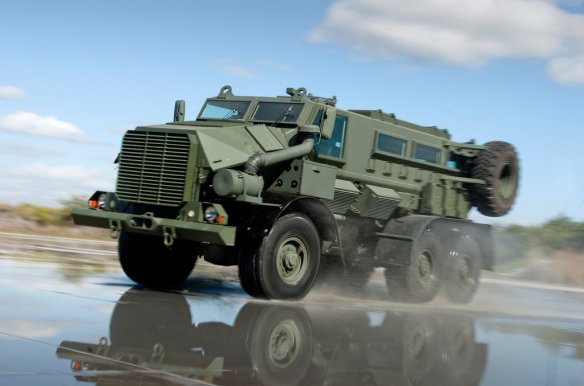BAE Systems has launched the latest version of the highly successful Casspir mine protected armoured vehicle, the Casspir Mk 6. The Casspir Mk6 evolved from the reliable and renowned Casspir heritage. The latest development also incorporates experience from the battle proven RG31 (over 2400 in service) to ensure a superior and affordable APC.
BAE Land Systems South Africa said the new variant of the veteran armoured personnel carrier can accommodate 16 people, and incorporates improvements gained from experience with the battle proven RG31. More than 2400 RG31s are in service and the type has seen extensive combat in places like Iraq and Afghanistan.
The Casspir Mk6 is an open architecture fit for many applications including the option for different variants – 4×4, 6×6, utility, APC and command. This battle-proven workhorse with its robust design is suitable for the harshest African conditions. COTS (Commercial-off-the-shelve) building blocks are used in the design and manufacturing for increased cost benefit and contributing to the superior mine protection is the monocoque V-shaped hull.
The Casspir Mk6 measures approximately 7.59 meters in length, 2.67 meters in width, with a ground clearance of 380 millimeters. Its gross vehicle mass is 14,320 kg and seats 16 crew members. The straight forward utilisation of a total commercial drive train ensures affordability of this battle proven vehicle. Some of the weight comes from armour plating used in the innovative V-shaped hull, which deflects land mine blasts.
The Casspir Mk 6 is primarily aimed at the African market, but will be marketed overseas as a lower cost mine protected vehicle. The new variant has no orders at present, but BAE will commence marketing it soon.
The new model Casspir Mk6 has 3-axle all-wheel drive chassis, whereas all previous Casspirs were and are four-wheel drive. However, 4×4 version is available as an option for this new model. The Casspir Mk 6 is developed on the chassis of the Russian truck Ural 4320 with YAMZ 236NE2 turbocharged engine rated at 230 hp and manual gearbox YAMZ-236U. Using Russian components give 30% price decrease – the final cost of the Casspir Mk6 is about USD350,000. The idea of using Ural’s chassis was suggested by Indian company Mahindra & Mahindra. So, the new vehicle has the monocoque V-shaped hull of the Casspir, mounted on chassis of Russian truck.
Originally developed by the then-Defence Research Unit of the Council for Scientific and Industrial Research on a budget of R80 000 to a South African Police requirement for an armoured, mine-protected counterinsurgency vehicle – hence the name “Casspir”, an anagram for SAP and CSIR – the vehicle was also adopted in that role by the SA Army.
An estimated 2500 Casspirs were built since the first prototype rolled out of the TFM plant in April 1979 and about 170 remain in South African Army service. Some 167 Casspirs were upgraded in 2006 as part of Project Gijima.
This quintessential mine resistant, armour protected, personnel carrier is seen as one of two inspirations of the MRAP that now proliferates worldwide, the other being the TFM, (now BAE Systems SA, Land Systems OMC) RG31.
During the Namibian-Angolan Border War (1966-1989), the Casspir served, inter alia with the South African police counterinsurgency unit commonly known as “Koevoet”, the South West African Territory Force’s 101 Battalion and the SA Defence Force’s 5 Reconnaissance Regiment (5RR). After the end of the war the 101Bn vehicles were returned to the SA Army and assigned to the motorised infantry.
The Casspir has also entered service with more than half a dozen other nations, including India, Nepal, Indonesia, Djibouti and Mozambique, amongst others.
